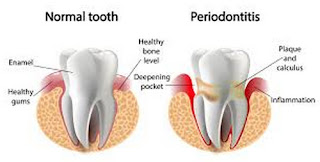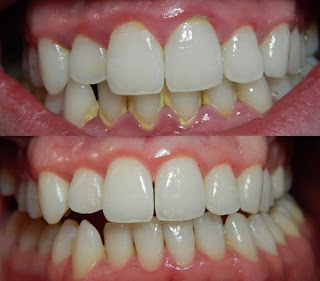What is a gum disease?
A gum disease medically known as periodontal disease is an infection of the tissues that keep the teeth in place. There is a variety of factors that lead to gum diseases such as poor hygiene and bacterial infection. A gum disease should be treated as soon as possible.If it reaches the advanced stage, it could lead to sore and painful gums, which could cause you to losing your teeth. (1, 2, and 3)
picture 1: A comparison image of a healthy gum and a gum disease.
image source: i.ytimg.com
picture 2: An advanced form of a gum disease.
image source: www.efp.org
image source: www.efp.org
picture 3: A comparison image between a healthy tooth and a tooth with gum disease.
image source: encrypted-tbn0.gstatic.com
image source: encrypted-tbn0.gstatic.com
picture 4: An image showing a healthy gum, a gum with gingivitis, and a gum with periodontitis.
image source: i1.wp.com
image source: i1.wp.com
picture 5: A gingivitis has a plaque buildup/tartar which requires professional intervention to be removed thoroughly.
image source: cdn1.medicalnewstoday.com
image source: cdn1.medicalnewstoday.com
What causes gum disease?
There are naturally residing bacteria in the mouth. They are good bacteria, but once their number grows out of control, it could lead to infection. Excessive bacterial growth can be caused by poor hygiene, smoking, hormonal imbalance especially in women, side effects of medication, diabetes, crooked or overlapping teeth, excessive alcohol intake, and poor nutrition. (4, 5)Gum disease symptoms
- halitosis (bad breath) that won't go away
- swollen gums
- sensitive teeth
- bleeding gums (4)
- trouble/pain when chewing
- receding gums
- the teeth appear longer
- loose teeth (5)
Types of periodontal disease
- gingivitis - It is a mild form of gum disease characterized by red and swollen gums. There is also a possibility of gum bleeding.
- periodontitis - It is the advanced form of gingivitis. The gums separate from the teeth and form pockets leading to a severe infection. As the infection advances, more gum tissues are destroyed including the bones. (5, 6, and 7)
picture 6: A periodontal probe is used to check and measure pocket depths.
image source: www.moderndentistry.com
image source: www.moderndentistry.com
picture 7: A dental x-ray is ordered to check for bone loss.
image source: yourdentalhealthresource.com
image source: yourdentalhealthresource.com
picture 8: Some of the natural remedies for gum disease.
image source: i.ytimg.com
image source: i.ytimg.com
Diagnosis
The doctor will thoroughly examine your gums for any signs of inflammation. A probe is used to check for pockets and measure the size. Aside from the routine check, the doctor will also ask questions regarding your oral hygiene as well as activities that could increase the risk of gum diseases such as smoking and diabetes mellitus. An x-ray is also ordered to check for any signs of bone loss.
Periodontal disease treatment
How to get rid of gum disease? What is the best gum disease treatment? The type of treatment varies depending on the nature and extent of infection. Most of the treatments require the patient to maintain good oral hygiene and avoid doing things that can further aggravate the condition such as smoking. The doctor might prescribe antibiotics, pain reliever, and anti-inflammatories. The rest can be done right in the comfort of home. Gum disease treatment at home include the following:- hydrogen peroxide - Its antibacterial property makes it effective in killing harmful microorganisms in the mouth.
- green tea - It helps reduce inflammation.
- baking soda diluted in water - It neutralizes the acid in the mouth that might cause gum disease.
- saltwater rinse - It destroys bacteria and reduces inflammation. (6, 8, and 9)
How to prevent gum disease?
- Observe a good oral hygiene. Make it a habit to brush your teeth two to three times a day using a fluoride-rich toothpaste.
- Floss regularly.
- Visit your dentist for a routine check every six months.
- Quit smoking. (1, 10)
References
- https://www.nidcr.nih.gov/health-info/gum-disease/more-info
- https://www.perio.org/consumer/types-gum-disease.html
- https://www.colgate.com/en-us/oral-health/conditions/gum-disease
- https://www.webmd.com/oral-health/guide/gingivitis-periodontal-disease#1
- https://www.dhsv.org.au/dental-health/teeth-tips-and-facts/periodontitis
- https://www.mouthhealthy.org/en/az-topics/g/gum-disease
- https://www.medicinenet.com/gum_disease/article.htm
- https://www.cda-adc.ca/en/oral_health/talk/complications/diseases/gum_diseases.asp
- https://www.efp.org/patients/what-is-periodontitis.html
- https://www.nhs.uk/conditions/gum-disease/









